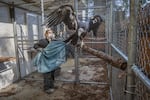The reintroduction program run by the Yurok Tribe has been bringing California condors, once at the brink of extinction, back to their ancestral lands since 2022.

Yurok Tribe condor biologist Evelyn Wilhelm captures A9 for treatment at the Sequoia Park Zoo Condor Care Center in this undated provided photo.
Courtesy of Maddy Rifka/Yurok Tribe
Condors are carrion eaters, feeding on carcasses they find across the landscape. Poached elk killed with lead ammunition last year led to one condor needing treatment. This year, another condor — known as A9 — was sent to the nearby Sequoia Park Zoo for treatment after staff found potentially lethal levels of lead in its blood during routine health checks. Eight other condors had detectable levels of lead in their blood, but they were below the threshold used to decide if they should receive chelation therapy treatment.
“We administer calcium EDTA that binds to the lead particles in their blood and allows them to be carried more efficiently to the kidneys for excretion,” explained Chris West, condor program manager for the Yurok Tribe.
West said that this chelation treatment, while life-saving, can also be hard on the condors, and it’s better to let those with lower levels of lead slowly clear it from their systems.
Condor A9 had just been released into the wild this year, in early October.
West said they haven’t found an exact source for the lead this time, but they can guess based on the bird’s GPS trackers.
“They don’t wander along roadways,” he said. “So really the only source that they encounter naturally in the environment is in the food that they intake.”
West said they saw condor A9 land on an unoccupied piece of property next to an old barn, which could have been the site of game processing or poaching, but it can be hard to keep track of everywhere the condors are going and eating.
Lead is the single greatest threat to recovery for California condors. According to the U.S. Fish and Wildlife Service, lead poisoning contributed to half of all known wild condor deaths between 1992 and 2020.

Northern California Condor Restoration Program Manager, Chris West captures A9 for treatment at the Sequoia Park Zoo Condor Care Center in this undated provided photo.
Courtesy of Maddy Rifka/Yurok Tribe
While lead ammunition has been banned for hunting in California since 2019, West said that other people who use firearms, like ranchers to control predators, may not be aware of the bans.
“Big game hunters are definitely using firearms on the landscape,” he said. “They also probably have the best pathways to information about non lead ammunition and the effects of lead.”
West said his staff spend a significant amount of time removing lead-tainted animals from the area and reaching out to gun owners. Right now, these condors, along with others populations in recovery across the U.S., rely heavily on human intervention to ensure they don’t die from lead poisoning. West said compared to other endangered species, condors are actually pretty lucky.
“Because it’s really a one-stop shop,” he said. ”It’s like, ‘There it is, it’s lead.’ Fix lead, condors are fixed and we can all go on our way and not have to deal with this anymore and condors can take over.”
On the bright side, West said that condor A9 was released on Monday after three weeks of treatment.
This republished story is part of OPB’s broader effort to ensure that everyone in our region has access to quality journalism that informs, entertains and enriches their lives. To learn more, visit our journalism partnerships page.